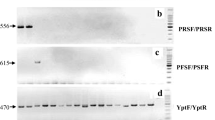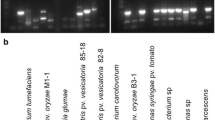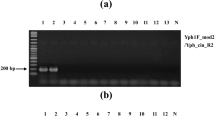Abstract
Pistachio dieback occurs in the main pistachio growing areas of Australia. Xanthomonas strains belonging to the translucens group have been identified as the causal agent of the disease and two distinct groups, A and B, have been recognised within the pathogen population. In this study, specific primers for amplification of DNA of the pathogen were developed by sequencing the Internal Transcribed Spacer (ITS) region of rDNA from strains representing groups A and B, as well as from X. translucens isolated from wheat in Australia and one Xanthomonas translucens strain from orchard floor grasses. Primers were designed for amplification of DNA sequences specific to each group and a multiplex PCR test was developed that identified and differentiated strains of each group in a single PCR assay. To determine the specificity of the primers, PCR was carried out with DNA from 65 strains of the pistachio pathogen, 31 type and reference strains of Xanthomonas, and from 191 phytobacteria commonly found in and around pistachio orchards. In the multiplex PCR, a 331 bp fragment was amplified from all strains belonging to group A and a 120 bp fragment from all strains in group B. No PCR products were obtained from the other bacteria tested except for the type strain of X. translucens pv. cerealis, which has not been found in Australia. The assay was used to detect strains from both groups of the pathogen in pistachio plant material.
Similar content being viewed by others
References
Adachi N, Oku T (2000) PCR-mediated detection of Xanthomonas oryzae pv. oryzae by amplification of the 16S–23S rDNA spacer region sequence. Journal of General Plant Pathology 66: 303–309
Alvarez A (2001) Serological techniques. In: Schaad NW, Jones JB, Chun W (eds) Laboratory Guide for Identification of Plant Pathogenic Bacteria, 3rd edn. American Phytopathological Society, St. Paul, Minnesota, USA, pp. 338–339
Anon (2002) Pistachio Growers Association Strategic Plan. Pistachio Growers Association Incorporated, Horticulture Australia Limited, Sydney, Australia
Azad H, Schaad NW (1988) Serological relationships among membrane proteins of strains of Xanthomonas campestris pv. translucens. Phytopathology 78: 272–277
Barry T, Glennon CM, Dunican LK, Gannon F (1991) The 16S/23S ribosomal spacer region as a target for DNA probes to identify eubacteria. PCR Methods and Applications 1: 51–56
Bragard C, Verhoyen M (1993) Monoclonal antibodies specific for Xanthomonas campestris bacteria pathogenic on wheat and other small grain, in comparison with polyclonal antisera. Journal of Phytopathology 139: 217–228
DeParasis J, Roth DA (1990) Nucleic acid probes for identification of phytobacteria: Identification of genus-specific 16S rRNA sequences. Phytopathology 80: 618–621
Facelli E, Taylor C, Scott E, Emmett R, Fegan M, Sedgley M (2002) Bacterial dieback of pistachio in Australia. Australasian Plant Pathology 31: 95–96
Facelli E, Taylor C, Scott ES, Emmett RW and Sedgley M (2003) Where in a pistachio tree is Xanthomonas translucens. In: Proceedings of the 8th International Congress of Plant Pathology (p. 17) Christchurch, New Zealand
Facelli E, Taylor C, Scott E, Fegan M, Huys G, Emmett R, Noble D, Sedgley M (2005) Identification of the causal agent of pistachio dieback in Australia. European Journal of Plant Pathology 112: 155–165
Fan XY, Hu ZY, Xu FH, Yan ZQ, Guo SQ, Li ZM (2003) Rapid detection of rpoB gene mutations in rifampin-resistant Mycobacterium tuberculosis isolates in Shanghai by using the amplification refractory mutation system. Journal of Clinical Microbiology 41: 993–997
Fegan M, Croft BJ, Teakle DS, Hayward AC, Smith GR (1998) Sensitive and specific detection of Clavibacter xyli subsp. xyli, causal agent of ratoon stunting disease of sugarcane, with a polymerase chain reaction-based assay. Plant Pathology 47: 495–504
Fox GE, Pechman KR, Woese CR (1977) Comparative cataloging of 16S ribosomal ribonucleic acid: Molecular approach to procaryotic systematic. International Journal of Systematic Bacteriology 27: 44–57
Glick DL, Coffey CM, Sulzinski MA (2002) Simultaneous PCR detection of the two major bacterial pathogens of geranium. Journal of Phytopathology 150: 54–59
Goncalves ER, Rosato YB (2000) Genotypic characterization of xanthomonad strains isolated from passion fruit plants (Passiflora spp.) and their relatedness to different Xanthomonas species. International Journal of Systematic and Evolutionary Microbiology 50: 811–821
Goncalves ER, Rosato YB (2002) Phylogenetic analysis of Xanthomonas species based upon 16S–23S rDNA intergenic spacer sequences. International Journal of Systematic and Evolutionary Microbiology 52: 355–361
Gurtler V, Stanisich VA (1996) New approaches to typing and identification of bacteria using the 16S–23S rDNA spacer region. Microbiology 142: 3–16
Hauben L, Vauterin L, Swings J, Moore ER (1997) Comparison of 16S ribosomal DNA sequences of all Xanthomonas species. International Journal of Systematic Bacteriology 47: 328–335
Henegariu O, Heerema NA, Dlouhy SR, Vance GH, Vogt PH (1997) Multiplex PCR: Critical parameters and step-by-step protocol. BioTechniques 23: 504–511
Honeycutt RJ, Sobral BWS, McClelland M (1995) tDNA intergenic spacers reveal polymorphisms diagnostic for Xanthomonas albilineans. Microbiology 141: 3229–3239
Jayne AB, Taylor EJA (2001) Scorpion ARMS primers for SNP real-time PCR detection and quantification of Pyrenophora teres. Molecular Plant Pathology 2: 275–280
John ME (1992) An efficient method for isolation of RNA and DNA from plants containing polyphenolics. Nucleic Acids Research 20: 2381
Koonjul PK, Brandt WF, Farrant JM, Lindsey GG (1999) Inclusion of polyvinylpyrrolidone in the polymerase chain reaction reverses the inhibitory effects of polyphenolic contamination of RNA. Nucleic Acids Research. 27: 915–916
Lane DJ (1991) Small subunit ribosomal RNA sequences and primers. Large subunit ribosomal RNA sequences and primers. In: Goodfellow E. (ed). Nucleic Acid Techniques in Bacterial Systematics. John Wiley & Sons, Chichester, UK, pp. 148–175
Louws FJ, Rademaker JLW, de Bruijn FJ (1999) The three Ds of PCR-based genomic analysis of phytobacteria: Diversity, detection, and disease diagnosis. Annual Review of Phytopathology 37: 81–125
Mach RL, Kullnig-Gradinger CM, Farnleitner AH, Reischer G, Adler A, Kubicek CP (2004) Specific detection of Fusarium langsethiae and related species by DGGE and ARMS-PCR of a [beta]-tubulin (tub1) gene fragment. International Journal of Food Microbiology 95: 333–339
Maes M, Garbeva P, Crepel C (1996a) Identification and sensitive endophytic detection of the fire blight pathogen Erwinia amylovora with 23S ribosomal DNA sequences and the polymerase chain reaction. Plant Pathology 45: 1139–1149
Maes M, Garbeva P, Kamoen O (1996b) Recognition and detection in seed of the Xanthomonas pathogens that cause cereal leaf streak using rDNA spacer sequences and polymerase chain reaction. Phytopathology 86: 63–69
Marefat A, Scott ES, Ophel-Keller K and Sedgley M (2006) Genetic, phenotypic and pathogenic diversity among xanthomonads isolated from pistachio (Pistacia vera) in␣Australia. Plant Pathology. DOI: 10.1111/j.1365-3059.2006.01437-x
Meng XQ, Umesh KC, Davis RM, Gilbertson RL (2004) Development of PCR-based assays for detecting Xanthomonas campestris pv. carotae, the carrot bacterial leaf blight pathogen, from different substrates. Plant Disease 88: 1226–1234
Newton CR, Graham A, Heptinstall LE, Powell SJ, Summers C, Kalsheker N, Smith JC, Markham AF (1989) Analysis of any point mutation in DNA. The amplification refractory mutation system (ARMS). Nucleic Acids Research 17: 2503–2516
Pan YB, Grisham MP, Burner DM (1997) A polymerase chain reaction protocol for the detection of Xanthomonas albilineans, the causal agent of sugarcane leaf scald disease. Plant Disease 81: 189–194
Rademaker JLW, de Bruijn FJ (1997) Characterization and classification of microbes by rep-PCR genomic fingerprinting and computer-assisted pattern analysis. In: Caetano-Anolles G, Gresshoff PM (eds) DNA Markers: Protocols, Application and Overviews. John Wiley & Sons, New York, USA, pp. 151–171
Saettler AW, Schaad NW, Roth DA (eds) (1989) Detection of Bacteria in Seed and Other Planting Material. American Phytopathological Society, St. Paul, Minnesota, USA, 127 pp
Schaad NW, Jones JB, Chun W (eds) (2001) Laboratory Guide for Identification of Plant Pathogenic Bacteria, 3rd edn. American Phytopathological Society, St. Paul, Minnesota, USA, 373 pp
Ye S, Dhillon S, Ke X, Collins AR, Day IN (2001) An efficient procedure for genotyping single nucleotide polymorphisms. Nucleic Acids Research 29: E88
Author information
Authors and Affiliations
Corresponding author
Rights and permissions
About this article
Cite this article
Marefat, A., Ophel-Keller, K., Scott, E.S. et al. The Use of ARMS PCR in Detection and Identification of Xanthomonads Associated with Pistachio Dieback in Australia. Eur J Plant Pathol 116, 57–68 (2006). https://doi.org/10.1007/s10658-006-9038-z
Received:
Accepted:
Published:
Issue Date:
DOI: https://doi.org/10.1007/s10658-006-9038-z




